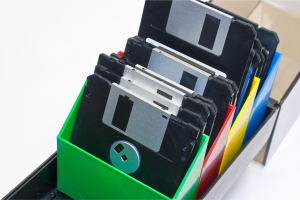1 An Introduction to the Digitization Industry
Introduction to the Digitization Field

As you begin your journey into the digitization industry, you might be surprised to learn that approximately 93% of the world’s information still exists only in analog format as of 2024. This presents an extraordinary opportunity for students entering the digitization industry, where skilled professionals are in high demand.
The digitization industry is experiencing unprecedented growth, driven by advances in artificial intelligence, cloud computing, and cybersecurity. Organizations across all sectors are investing heavily in digital transformation, with industry spending projected to reach trillions of dollars over the next decade. The COVID-19 pandemic has accelerated this transformation, causing a dramatic shift toward remote work that has made digital access to information more critical than ever.
Industry Applications and Success Stories
The digitization industry serves diverse clients with unique needs:
Government Agencies use digitization to:
- Improve form accessibility
- Streamline internal workflows
- Enhance citizen services
- Maintain regulatory compliance
Museums digitize collections to:
- Preserve artifacts
- Enable global access
- Support research collaboration
- Protect original materials
Businesses use digitization to:
- Improve form accessibility
- Enhance efficiency
- Streamline workflows
- Maintain regulatory compliance
- Improve data management
Success Stories
These examples highlight how Canadian organizations across different sectors are leveraging digitization to improve efficiency, compliance, and accessibility while preserving important records. Incorporating these case studies into your course material can provide students with concrete examples of the benefits and challenges associated with digitization projects.
Challenges Facing the Industry
Resistance to Change
Many organizations are hesitant to adapt to new workflows. Whether this is due to fear of disruption, reliance on paper-based workflows, concerns about employee training, cost concerns, hesitancy to learn something new or a stagnant mindset (i.e. “if it isn’t broken don’t fix it”). Moreover, there are concerns from employees who may not be well versed with technology and are more comfortable with traditional methods. This can be resolved by implementing change management and oversight. Training programs and educating employees on why and how the new software will help can ease some of these concerns and issues.
Legacy Systems
Many organizations still rely on older systems. Outdated software and even operating systems. It Is difficult for large corporations to migrate data, train users and update their systems however, it is critical. Not only for efficiency but also for security. Legacy systems have many well-known security flaws that updating can help address. Companies that are unwilling to update their systems pose a unique challenge when considering digitization. Integrating files into legacy systems can pose a challenge in regard to file size, file types and more.
Sustainability & Environmental Impact
Digitization can both help and harm the environment. While digitization reduces the need for physical paper and storage space, freeing up space for workers and reducing the need for industrial sprawl, it also introduces new concerns. Data centres, which house digital assets and run cloud computing services, consume vast amounts of energy. As more data is digitized, the demand for data storage and the associated energy use will only increase. Ensuring that digitization practices remain sustainable is a growing challenge, pushing companies and governments to seek energy-efficient solutions such as renewable energy-powered data centres and more efficient data management practices.
Data Privacy and Security
As our digital presence increases new challenges are introduced. The digital world is not free of crime and sabotage. As companies look to digitize critical data and assets, the protection of data becomes more important than ever. Data breaches, hacking, and unauthorized access pose significant threats to organizations’ digitized information. It is critical to ensure data privacy, security and sovereignty particularly in industries like healthcare, finance, and government, where sensitive personal information is handled. Encryption, secure access controls, regular audits and more are used to address this concern.
Essential Computer Operations in the Digitization Industry

In the digitization industry, mastering essential computer operations is crucial for ensuring smooth and efficient workflows. Whether you’re digitizing documents, managing large-scale data repositories, or working with specialized software, understanding how to operate a computer effectively is foundational to success. These operations are not just about basic tasks like using a mouse or keyboard—they encompass a wide range of actions that help users navigate digital environments, manage files, and ensure that systems run optimally.
Key Computer Operations in Digitization
File Management
One of the most fundamental computer operations is file management. This involves creating, organizing, and maintaining digital files in a structured manner. In the digitization industry, where vast amounts of data are processed daily, effective file management is critical.
Example: A digitization project involving historical archives might require scanning thousands of documents. Each scanned file needs to be saved in specific folders according to categories like year, subject matter, or document type. Without proper file management practices, finding specific documents later could become a nightmare.
Operating System Navigation
Understanding how to navigate an operating system (OS) is essential for accessing files, launching programs, and configuring system settings. Whether you’re using Windows, macOS, or Linux, knowing how to efficiently move around your OS will save time and reduce frustration.
Example: A digitization technician working on a Mac might need to configure system preferences to optimize performance for high-resolution scanning software.
Software Installation and Updates
Installing and updating software is another key operation. In the digitization industry, where specialized tools like Optical Character Recognition (OCR) software or document management systems (DMS) are used regularly, keeping these tools up-to-date ensures they run smoothly and securely.
Example: A team responsible for digitizing legal documents might use Adobe Acrobat Pro for PDF manipulation. Regular updates ensure the software remains compatible with new file formats and security protocols.
Basic Networking
Understanding basic networking concepts is important when working with cloud storage solutions or shared drives in a digitization project. Knowing how to connect to a network, troubleshoot connectivity issues, and manage shared resources can streamline collaboration.
Example: A library digitizing its collection may store scanned documents on a networked server that multiple team members can access simultaneously.
Data Backup and Recovery
Data loss can be catastrophic in any industry but especially in digitization where original physical documents may no longer exist after scanning. Regularly backing up data and understanding how to recover it if something goes wrong is vital.
Example: A museum digitizing rare manuscripts would need to back up all scanned images to both local storage devices and cloud-based platforms to ensure redundancy.
Basic Hardware Troubleshooting in Digitization

In any digitization project—whether you’re scanning documents or converting old media formats—hardware plays an essential role. Scanners, computers, storage devices, and other peripherals must function properly for the project to run smoothly. However, hardware issues are inevitable from time to time. Knowing how to troubleshoot common problems can save you time and prevent costly delays.
Scanner Malfunctions
Scanners are one of the most commonly used pieces of hardware in digitization projects—and they’re also prone to issues such as paper jams or poor image quality.
Troubleshooting Tip: If your scanner produces blurry images or fails to scan altogether:
-
- Check if the glass surface is clean.
- Ensure that the scanner drivers are up-to-date.
- Try adjusting resolution settings within your scanning software.
Storage Device Failures
External hard drives or network-attached storage (NAS) devices are often used for storing large volumes of digital files during a project. However, these devices can fail due to physical damage or corrupted data.
Troubleshooting Tip: If your external hard drive isn’t recognized by your computer:
-
- Try connecting it via another USB port or cable.
- Use disk utility tools (such as Windows’ Disk Management) to check for errors on the drive.
- Always keep backups of critical data on multiple devices!
Computer Performance Issues
Scanning high-resolution images or processing large video files can put significant strain on your computer’s CPU and memory—leading to slow performance or crashes.
Troubleshooting Tip: If your computer slows down during heavy tasks:
-
- Close unnecessary programs running in the background.
- Check if there’s enough free space on your hard drive (low disk space can slow down performance).
- Consider upgrading RAM if you frequently work with large files.
Peripheral Connectivity Problems
Printers/scanners often rely on USB connections—or wireless connections—to communicate with computers; however, connectivity issues may arise due faulty cables/drivers
Troubleshooting tip: Restart both devices
Fundamental Digital Preservation Strategies

As we’ve learned, digitization is a transformative process that converts physical assets into digital formats, unlocking new possibilities for accessibility and utility. However, not all digitized content is created equal in terms of long-term value. This is where digital preservation comes into play—not just to safeguard digital assets from technological obsolescence but also to make critical decisions about what should be preserved and why. By evaluating factors such as legal obligations, organizational significance, and potential limitations, digital preservation ensures that only the most valuable and meaningful content is preserved for the future. Let’s delve into the strategies and decision-making processes that underpin successful digital preservation.
What is Digital Preservation and Why is it Important?
According to Libraries and Archives Canada, Digital preservation is defined as “the active management of digital content over time to ensure ongoing access.”
To ensure ongoing access, digital preservation staff may need to monitor and intervene to protect content from technological obsolescence.
To guard against digital obsolescence, organizations enact Digital Preservation Strategies to help ensure that their data will not only survive over time, but will usable in a way that is meaningful to the organization.
The following short Library of Congress video produced in 2010 for the non-specialist audience explains how traditional information sources such as books, photos and sculptures can easily survive for years, decades or even centuries but digital items are fragile and require special care to keep them useable. Rapid technological changes also affect digital preservation. As new technologies appear, older ones become obsolete, making it difficult to access older content.
Reference: Library of Congress. (2011). Why digital preservation is important for everyone [Video]. YouTube. https://youtube.com/watch?v=qEmmeFfafUs (2:50min)
Technological or Digital Obsolescence

Digital obsolescence is the risk of data loss because of inabilities to access digital assets, due to the hardware or software required for information retrieval being repeatedly replaced by newer devices and systems, resulting in increasingly incompatible formats.
What Should be Preserved?
A Government of Canada decision-making tree is found below. As you hover over each of the decision points on the tree, a pop-up will appear that provides a brief explanation of each decision point.
First, we will consider the reasons that an organization may wish to preserve a document or an asset.
- Does the existing policy mandate that you should be preserving this document
Example: All documents pertaining to Human Resources Actions will be retained indefinitely
- Is there a legal obligation
Example: Documents filed with the Supreme Court of Canada must be preserved according to specific guidelines, including those that are classified as confidential by legislation. https://scc-csc.ca/parties/gl-ld2021-01-27-eng.aspx
- If the asset/document being considered is in digital format, and there is difficulty accessing the original, then the digital asset should be preserved.
- In this case, if the long-term value of the resource justifies digital preservation, then it should be preserved.
If, at this point in the decision tree, we are advised to preserve the resource, we should next consider if there are limiting factors that might prohibit preservation.
It Won’t Happen to Me
This true story brings home the necessity of having a plan, and avoid potential disaster. It’s an entertaining and informative story of how ‘Toy Story 2’ was almost deleted from Pixar Animation’s computers during the making of the film and how the film was saved by one mom’s home computer.
Reference: @HOLLYWOOD. (2013). How Toy Story 2 almost got deleted: Stories from Pixar Animation: ENTV [Video]. YouTube. https://youtube.com/watch?v=8dhp_20j0Ys (2:25min)
Introduction to Digitization Software

Converting physical documents into digital files is just one possible beginning of the digitization process. Items “born digital” such as word documents, PDF files, emails, faxes etc. are also digitized. To make these digital documents truly useful and accessible, we need specialized software to process, organize, and optimize them. In this chapter, we’ll explore the fundamental software applications used in the digitization industry.
Digitization software plays a pivotal role in converting physical materials into digital formats. From simple document scanning tools to advanced image processing applications, these programs help streamline the process of capturing, storing, and managing digital content.
Understanding Document Capture Software

The digitization process begins with document capture software, which works hand-in-hand with scanning hardware. This software controls scanner settings and helps ensure that documents are captured correctly the first time. Modern capture software can automatically enhance image quality, straighten skewed pages, and even detect when multiple pages have been fed through the scanner simultaneously. These automatic adjustments save time and help maintain consistency across large scanning projects.
The Power of Optical Character Recognition
After documents are scanned, they go through a process called Optical Character Recognition, or OCR. Think of OCR as teaching a computer to read. The software analyses the patterns of light and dark in the document image and converts them into machine-readable text. This transformation is crucial because it allows users to search through documents, copy and paste text, and edit content that was originally locked in a paper format.
When a document goes through OCR processing, the text becomes searchable, making it much easier to find specific information later. For example, if you needed to find every document that mentioned a particular client name, you could simply search for that name instead of manually reading through hundreds of pages. This capability dramatically improves efficiency and accessibility in any organization that deals with large volumes of documents.
Data Entry Systems
While OCR technology is powerful, many digitization projects still require human input to capture specific information about each document. This is where data entry software comes in. Modern data entry systems are designed to make this process as efficient as possible.
A typical data entry interface shows the scanned document on one side of the screen and data entry fields on the other. These fields are used to record important information about the document, often called metadata. For instance, when processing invoices, an operator might need to enter the invoice number, date, and total amount. This information becomes part of the document’s digital record, making it easy to organize and retrieve files later.
Data entry software often includes features to help prevent errors, such as dropdown menus with predetermined options and automatic format checking. These features help ensure that information is entered consistently and accurately across all documents.
Benefits of Using Data Entry Software
Using specialized software for your data entry tasks offers several key benefits:
- Increased Accuracy: Automated features—like pre-built templates or validation rules—help reduce human error during the input process.
- Time Savings: Automation tools such as OCR drastically reduce the amount of time spent manually entering large volumes of information.
- Scalability: As your organization grows—so does your need for efficient ways to handle increasing amounts of incoming information; scalable solutions like ERPs ensure you won’t outgrow your current system.
- Improved Collaboration: Cloud-based platforms enable multiple users across different locations/departments access real-time updates simultaneously without needing separate copies stored locally on individual devices.
- Enhanced Security & Compliance: Many modern platforms include built-in security features such as encryption/password protection ensuring sensitive personal/business-related info remains protected against unauthorized access breaches while also helping meet regulatory compliance standards set forth within respective industries i.e., GDPR HIPAA PCI DSS etc.).
Types of Data Input Software
Optical Character Recognition (OCR) Software
OCR technology converts scanned images or PDFs into machine-readable text—automating much of the manual work involved in entering information from physical documents.
Example: A law firm might use OCR software to scan contracts and automatically extract key details like client names or contract dates for storage in their document management system.
Quality Control Software
Quality control is essential in digitization work. QC software helps operators review the quality of scanned images and verify that all information has been captured correctly. When using quality control software, operators can zoom in to check fine details, adjust brightness and contrast to ensure text is readable, and mark any problems that need to be addressed.
The software typically allows operators to move efficiently through batches of documents, flagging any issues they find along the way. These might include poor image quality, missing pages, or incorrect data entry. By catching and correcting problems early in the process, quality control software helps ensure that the final digital documents meet the required standards.
Document Management Integration
The final piece of the digitization software puzzle is integration with document management systems. Once documents have been scanned, processed with OCR, tagged with metadata, and quality checked, they need to be stored somewhere that makes them easily accessible to the right people.
Document management systems provide secure storage for digital files and allow organizations to control who can access different types of documents. These systems make it possible to find documents quickly using the metadata entered during processing, and they often include features for tracking document versions and maintaining audit trails of who has accessed or modified files.
Watch this video to discover how DMS streamlines document organization, indexing, and retrieval, making document management a breeze. Learn about key features like version control, access control, and workflow automation, all essential for efficient document handling.
Reference: BusinessGuide360. (2024). How document management system works? [Video]. YouTube. https://youtube.com/watch?v=Quzp0UPV2tM (2:13min)
Other Types of Digitization Software
Kodak Capture Pro Software
Kodak Capture Pro is a robust scanning and document management solution designed for high-volume, mission-critical applications. It supports both Kodak and non-Kodak scanners, making it versatile for various business needs. Key features include:
- Batch Scanning and Indexing: Efficiently scans and indexes documents, supporting color, grayscale, and black-and-white modes.
- Post-Scan Editing: Offers tools for cropping, blanking, and rotating scanned images to ensure accuracy and quality.
- Automation: Automates indexing using Optical Character Recognition (OCR) and barcode reading for faster processing.
- Integration: Easily integrates with Enterprise Content Management (ECM) systems or file systems for seamless workflow management.
- Intelligent Job Select: Automatically configures scanner settings and indexing based on document types, optimizing efficiency in environments with diverse scanning.
Tungsten Capture/Total Agility
Tungsten Capture (formerly Kofax Capture) is an enterprise-level document capture platform that automates the processing of paper and electronic documents. It is highly scalable and integrates advanced technologies like AI and machine learning. Key highlights include:
- Document Processing: Captures data from various sources such as scanners, emails, faxes, or mobile devices.
- Data Extraction: Utilizes OCR and machine learning to extract actionable data from structured, semi-structured, or unstructured documents.
- Scalability: Supports centralized or distributed environments across global enterprises.
- Cognitive Automation: Incorporates AI for automatic document classification, separation, and validation to enhance accuracy and reduce errors.
- Mobile Integration: Offers mobile capture capabilities for real-time data extraction from images or videos on Android/iOS devices.
Image Editing Software
Image editing tools like Adobe Photoshop or GIMP are often used when museums or other archives scan collection items. This software will clean up scanned images by adjusting contrast levels or removing blemishes from old photographs.
Example: A historical society might use Photoshop to enhance faded photographs before uploading them to an online archive for public viewing.
Audio/Video Digitization Software
For projects involving audio or video materials—such as oral histories or film archives—specialized software like Audacity (for audio) or HandBrake (for video) is used to convert analog recordings into digital formats.
Example: A university digitizing its collection of VHS tapes might use HandBrake to convert videos into MP4 format for easier storage and access.
Digitization Software Summary
The software used in digitization projects works together to transform paper documents into searchable, accessible digital files. From initial capture through OCR processing, data entry, quality control, and final storage, each piece of software plays an important role in creating useful digital documents. Understanding these tools and how they work together is essential for anyone entering the digitization field.
Fundamentals of Data Entry

In the digitization industry, data entry is a critical process that serves as the backbone for numerous operations. Whether it’s entering customer information, financial records, or product inventories, data entry ensures that essential information is accurately captured and stored in digital systems. While it may seem like a simple task, data entry requires precision, consistency, and attention to detail to avoid costly errors.
What is Data Entry?
Data entry refers to the process of inputting information into a computer system or database from various sources such as paper documents, forms, or other digital formats. This could range from entering customer details into a CRM (Customer Relationship Management) system to logging sales transactions in an accounting software. The goal is to ensure that data is accurately and efficiently digitized for future use.
Types of Data Entry
Data entry tasks can vary widely depending on the industry and the specific needs of an organization. Here are some common types of data entry:
- Manual Data Entry: This involves manually typing or inputting data from physical or digital documents into a system. For example, entering customer information from paper forms into a digital CRM.
- Automated Data Entry: Automated data entry uses software tools like OCR (Optical Character Recognition) to scan documents and extract relevant information automatically. This method is faster than manual entry but requires validation to ensure accuracy.
- Numeric Data Entry: Numeric data entry focuses on inputting numerical information such as financial figures, inventory counts, or statistical data.
- Textual Data Entry: Textual data entry involves entering alphanumeric content such as names, addresses, and descriptions into systems like databases or spreadsheets.
- Transcription: Transcription is a specialized form of data entry where audio or video recordings are converted into written text.
Why is Data Entry Important?
Data entry plays a crucial role in the digitization process because it serves as the foundation for all subsequent tasks like analysis, reporting, and decision-making. Here’s why it’s so important:
- Accuracy: Accurate data entry ensures that the information stored in your systems is reliable and can be used for critical business decisions.
- Efficiency: Efficient data entry speeds up workflows by ensuring that information is captured quickly and stored in an organized manner.
- Compliance: In industries like healthcare and finance, accurate data entry is essential for compliance with regulatory requirements.
- Customer Satisfaction: Inaccurate customer records can lead to poor service experiences. Proper data entry ensures that customer interactions are smooth and personalized.
Challenges in Data Entry
Despite its importance, data entry comes with its own set of challenges:
- Human Error: Manual data entry is prone to mistakes such as typos or incorrect formatting.
- Time-Consuming: Entering large volumes of data manually can be time-consuming and labour-intensive.
- Repetitive Nature: The repetitive nature of data entry tasks can lead to fatigue and decreased accuracy over time.
- Data Validation: Ensuring that the entered data is correct and consistent can be challenging without proper validation techniques (more on this later).
Understanding these fundamentals sets the stage for exploring the tools and techniques designed to improve the efficiency and accuracy of data entry processes.
Error Prevention and Quality Control
Data entry operations form the backbone of modern digitization services. For professionals entering the digitization workforce, understanding how to maintain data integrity is crucial for success in document conversion operations. Mastering data entry fundamentals enables workers to prevent common errors and implement effective quality control measures in their daily digitization work. This includes following standardized operating procedures and clear instructions specifically designed for quality assurance processes.
Quality data entry professionals must be able to identify and prevent common errors, apply effective prevention strategies, understand the implications of data quality issues on digital outputs, and implement robust quality control measures. These skills form the foundation of efficient document conversion management. A key component of this foundation is the systematic tracking of errors through established metrics and the analysis of error reports based on regular sampling of digitized records.
Understanding Common Data Entry Errors
Transcription errors occur during manual data input and include typos, duplicate entries, and omitted information. These errors can be significantly reduced through regular typing practice using 10-key training programs, implementing double-entry verification, and maintaining focus through scheduled breaks.
Transposition errors happen when characters or numbers are accidentally switched, such as typing “12” as “21” or “Smith, John” as “John, Smith”. Organizations will attempt to prevent these errors by implementing systematic data verification protocols and using checksums for numerical data validation.
Unit and representation inconsistencies arise when data formats vary across entries. This includes differences in date formats (MM/DD/YY vs. DD/MM/YY), time notation (12-hour vs. 24-hour format), measurements (metric vs. imperial), and address styles (domestic vs. international formats). Organizations can minimize these inconsistencies by establishing standardized data entry templates and providing clear formatting guidelines.
Professional Roles and Requirements

Today’s digitization professionals are far more than technical operators. They are digital preservation specialists, Document Manifesters, and Indexer/Quality Control Operators. The field demands a unique combination of technical expertise and soft skills. While you’ll need to master specific tools and technologies, equally important is your ability to:
- Develop efficient workflows for large-scale projects
- Ensure the highest standards of quality control
- Collaborate with diverse teams and stakeholders
- Adapt to rapidly evolving technology
Here is a more detailed explanation of two entry level positions:
Document Manifester
The Document Manifester is responsible for accurately entering essential indexing information in regards to receiving, storing and retrieving documents.
Responsibilities:
- Accurate data entry
- Database searches
- Secure document storage
- Document retrieval
- Shipment coordination
Qualifications:
- High school diploma or equivalent
- Data entry experience
- Microsoft Suite proficiency
- Detail orientation
Competencies:
- Quality focus
- Safety and security awareness
- Dependability
- Responsiveness
- Problem-solving ability
Physical Requirements:
- Extended computer use
- Hand-finger dexterity
- Close vision capability
- Occasional lifting up to 50 pounds
Indexer/Quality Control Operator
The Indexer/Quality Control Operator is responsible for organizing and categorizing digital records to ensure they are easily searchable and retrievable. They perform quality checks to verify the accuracy of digitized documents, ensuring that images and metadata meet specified standards and are free from errors such as skewed images or illegible text. Additionally, they may use both manual and automated processes to index documents, and they play a critical role in validating the accuracy of the indexing through detailed review and comparison.
Responsibilities:
- High-accuracy data entry
- Document categorization
- Quality verification
- Process implementation
- Error identification and correction
Qualifications:
- 50 WPM minimum typing speed
- High school diploma
- Quality control knowledge
- Team collaboration skills
Competencies:
- Attention to detail
- Process adherence
- Continuous improvement focus
- Feedback application
- Goal orientation
- Persistence
- Risk assessment ability
Skills and Work Environment
The digitization workplace combines independent work with team collaboration. The COVID-19 pandemic has accelerated the trend toward remote work, making digital transformation even more crucial for organizations. Learn more about the work skills needed and work environment in the digitization industry:
Looking Ahead: Career Development

The digitization field offers excellent growth potential as organizations continue their digital transformation journey. Opportunities span various sectors:
- Healthcare organizations digitizing patient records
- Legal firms creating searchable case archives
- Financial institutions managing transaction records
- Educational institutions preserving research materials
- Government agencies modernizing citizen services
Chapter Conclusion
As you wrap up this chapter, take a moment to reflect on the transformative power of digitization. From preserving historical treasures to streamlining modern business operations, digitization stands at the crossroads of technology and human innovation. This field not only safeguards our past but also paves the way for an efficient and sustainable future.
The knowledge and skills you’ve explored in this reading are more than just tools; they are your entry point into a dynamic and ever-growing industry. Whether it’s mastering the intricacies of Optical Character Recognition, ensuring data quality and security, or understanding the nuances of digital preservation, every concept is a stepping stone toward real-world impact.
Think about the success stories you’ve encountered—from museums opening their archives to global audiences, to businesses revolutionizing their workflows. These examples are more than anecdotes; they are proof of what’s possible when expertise meets technology. At the same time, the challenges discussed—from data privacy concerns to the environmental impact of digitization—highlight the responsibility that comes with this work. As future professionals, you’ll play a key role in addressing these issues with creativity and critical thinking.
The digitization industry isn’t just about technology; it’s about people. It’s about connecting communities, empowering organizations, and creating systems that are as accessible as they are reliable. This journey is yours to shape. With the foundational knowledge you’ll be gaining here, you’re not just stepping into a career; you’re becoming a part of a movement that defines how the world interacts with information.
Key Takeaways
The digitization industry offers diverse career opportunities
Technical skills must be balanced with attention to detail
Quality control and error prevention are crucial
The field continues to grow with new technologies
Workplace flexibility and continuous learning are essential
In the next chapter, we’ll explore specific digitization technologies and processes in greater detail, building on these foundational concepts to develop your practical skills in the field.

